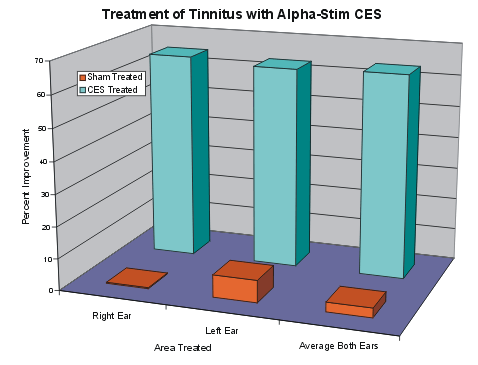Engelberg, M, & Bauer, W. Transcutaneous electrical stimulation for tinnitus. Laryngoscope, 95(10):1,167-1,173, 1985. Presented at the Meeting of the Southern Section of the American Laryngological, Rhinological and Otological Society, New Orleans, Louisiana, January, 1985.
At the Veterans Administration Medical Center in Cleveland, Ohio, the use of Alpha-Stim electrical stimulation to treat tinnitus was evaluated in a two experiment study. In experiment 1, 7 males, and 3 females from 23 to 69 years old (mean of 43 years) reported a total of 18 ears with tinnitus. Otological and audiological evaluations revealed all subjects except 1 had varying degrees of sensory hearing loss. 1 - 17 treatments of 50 µA Alpha-Stim stimulation was given at 0.5, 1.0, or 2.0 Hz at 13 sites around the ear for 24 seconds to 2 minutes. The tinnitus was matched after each treatment with simulated sounds from a Norwest SG-1 Tinnitus Synthesizer using an ascending procedure. 6 of the 10 subjects reported at least a 60% improvement in 8 of 18 ears, confirmed by tinnitus matching. 3 additional subjects (3 ears) were undecided whether improvement had occurred. The permanence of improvement lasted from 8 hours to 2 months (last contact with the experimenter).
In experiment 2, 20 subjects were divided into 2 groups, an Alpha-Stim and a control group, in a single blind protocol. All subjects were male, with either normal hearing or sensory hearing loss, most having idiopathic or noise exposure tinnitus. Each subject received a baseline audiological evaluation utilizing standard equipment referenced to ANSI standards, of air conduction, speech reception threshold, most comfortable loudness level, speech discrimination (W-22 word lists), and when indicated, bone conduction, impedance battery, and tone decay. The treatment was identical to experiment 1 except the current was at 50 or 100 µA, and the stimulus duration was either 12 or 24 seconds at the 13 sites. After each treatment the tinnitus was again analyzed using the same protocol. The control group had the identical procedure repeated twice, the first time without stimulation, followed by actual stimulation. Of 17 ears treated in the experimental group, 2 ears (subject 8, both ears) were perceived as not having improved by stimulation. Thus, 9 of 10 subjects (90%) corresponding to 15 of 17 ears (88%) reported the stimulation as having improved the tinnitus. The decrease in tinnitus frequency for the subjective improvement ranged from 48% in subject 3 to complete remission (none) in the 6 ears combined for subjects 5, 7, 9, and 10. Subject 8 did not perceive a 19% decrease as being significant. In the control group of 15 ears, in only 1 ear did a subject believe there had been a change, and measurements indicated a 13% decrease in frequency. The range of change for the 15 ears was from +16 (after sham stimulation, frequency was measured as higher) to -22%. Once the control group had actual stimulation, 80% reported improvement in at least 1 ear. The measured decrease in tinnitus frequency ranged from 28% to complete remission (none) in 4 subjects.
Because both groups in experiment 2 had actual stimulation, the data was pooled. Improvement was perceived by 20 subjects in 27 of 33 ears (82%). In 10 cases there was complete remission. In the remaining 17 ears, the range of frequency decrease was from 28 to 92%. The permanence of the improvement ranged from 20 minutes to at least 6 months (last contact with experimentor). Most of the subjects had either 1 or 2 treatment sessions; however, 1 subject that had 7 sessions found that each session tended to increase the duration of improvement and he concluded that he could live with his tinnitus after the seventh session and requested to be discharged from the program. Neither age, duration of tinnitus prior to stimulation, nor frequency of the tinnitus appeared to be a determinant to the success of treatment. Some subjects reported the current of 100 µA as “pins pricking” but were able to tolerate that amperage. Others could not tolerate greater than 50 µA. There were no other adverse effects reported either during or immediately following stimulation.
A significant number of subjects reported improvement in hearing activity but this could not be verified by objective evaluation. The authors concluded that the 82% success rate in improvement in tinnitus implies a feasible treatment procedure.
|
